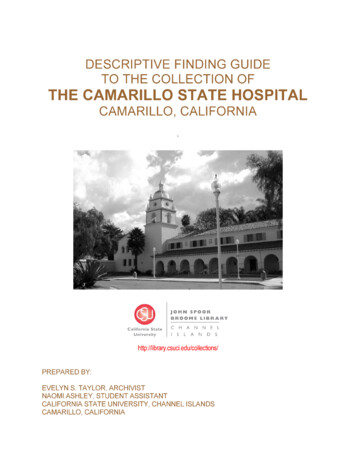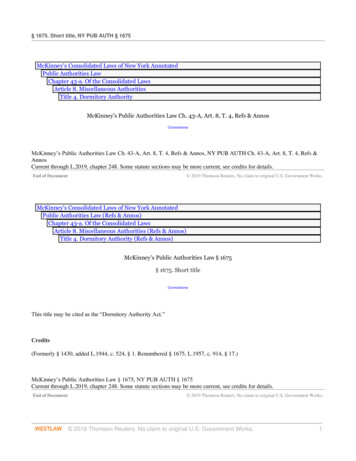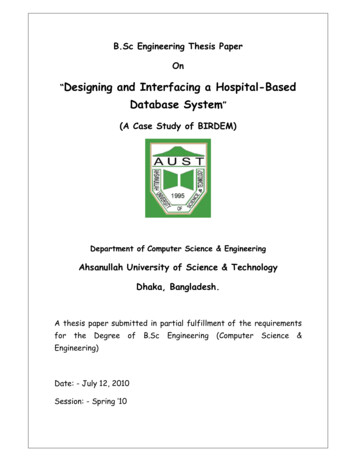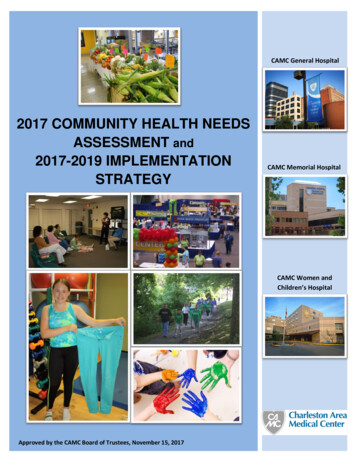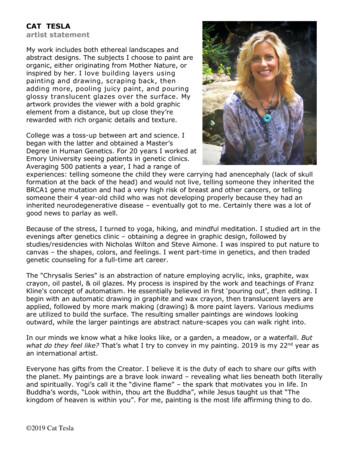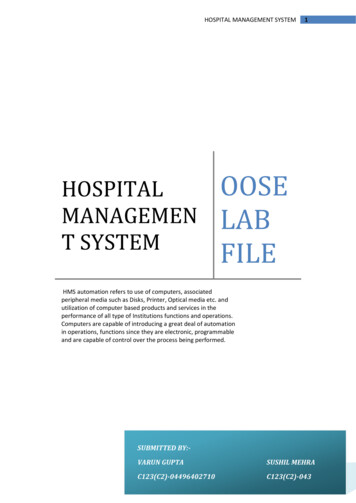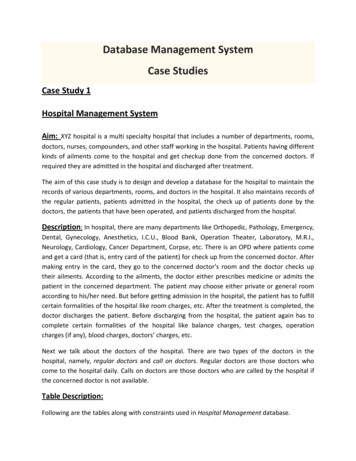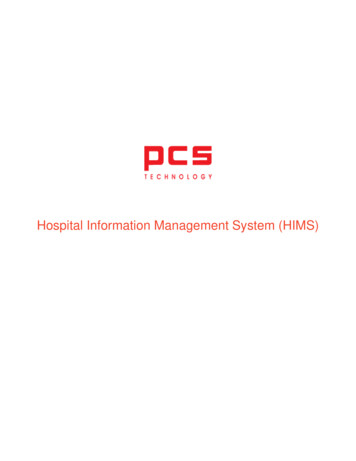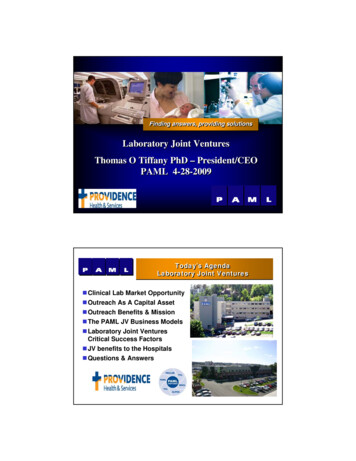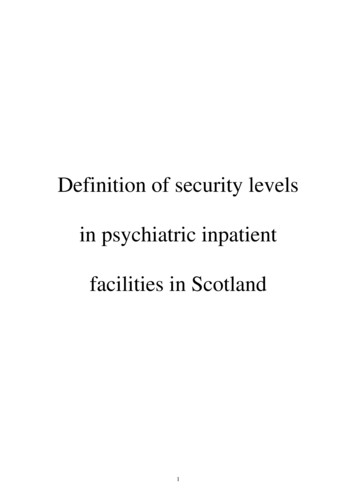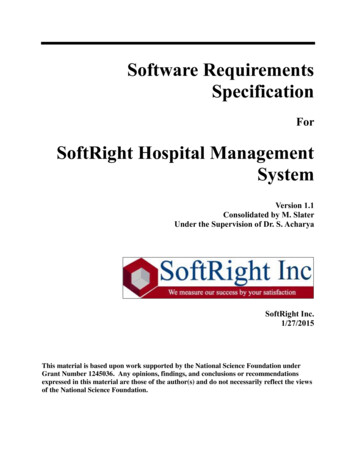
Transcription
Software RequirementsSpecificationForSoftRight Hospital ManagementSystemVersion 1.1Consolidated by M. SlaterUnder the Supervision of Dr. S. AcharyaSoftRight Inc.1/27/2015This material is based upon work supported by the National Science Foundation underGrant Number 1245036. Any opinions, findings, and conclusions or recommendationsexpressed in this material are those of the author(s) and do not necessarily reflect the viewsof the National Science Foundation.
Software Requirements Specification for SoftRight Hospital Management SystemPage iiAcknowledgementThis SRS is the result of a class assignment carried out by RMU’s Fall 2014 class of ENGR3410– Fundamentals of Software Engineering under the supervision of Dr. S. Acharya. Appreciationgoes to all the members of this class listed below: Michael ArturoBenedict MusniDonal HufferJared HorvitzJoshua PalmerAlex TruzziAndre SpratleyThank you guys! Shawn PerkinsDwight HerbTaylor WilliamsDevon CesarioAnthony KinestFernando V. LeiteRobbie Rareigh
Software Requirements Specification for SoftRight Hospital Management SystemPage iiiTable of ContentsAcknowledgement . iiTable of Contents . iiiRevision History . iv1. Introduction .11.11.21.31.41.5Purpose. 1Document Conventions . 1Intended Audience and Reading Suggestions . 1Project Scope . 1References . 12. Overall Description .22.12.22.32.42.52.62.7Product Perspective . 2Product Features. 2User Classes and Characteristics. 2Operating Environment . 3Design and Implementation Constraints . 3User Documentation . 3Assumptions and Dependencies. 33. System Features .43.1Radiology Information System . 43.2Picture Archiving and Communication System . 73.3Image Acquisition Modality System. 93.4Admit-Discharge-Transfer/Patient Registration System. 103.5Hospital Management System (HIS) . .33.5.4Patient Registration and scheduling . 4Radiology Department workflow management . 5Request and document X-Ray scanning . 5Result entry . 6Reporting and printout . 6Authentication . 7Image Viewer . 8Image Compression/Encryption Module . 8Login screen . 9Home page . 9Acquiring Image . 9Processing Image . 9Displaying Image . 10Admission . 10Registration . 11Transfer . 11Discharge . 12Token Authentication. 12Secure Connections . 12Efficient Database . 12User-Friendly GUI . 12
Software Requirements Specification for SoftRight Hospital Management SystemPage iv3.5.5 Technical Support . 134. External Interface Requirements .144.14.24.34.4User Interfaces . 14Hardware Interfaces . 14Software Interfaces . 15Communications Interfaces. 155. Other Nonfunctional Requirements .155.15.25.35.4Performance Requirements . 15Safety Requirements . 15Security Requirements . 16Software Quality Attributes . 16Appendix A: Glossary.16Revision HistoryNameDateReason For ChangesVersionMatthew Slater12/15/141.0Matthew Slater1/27/15Revised Sections, Changed ToC, UpdatedInformationRevised Sections and Errors based on ReviewFeedback1.1
Software Requirements Specification for SoftRight Hospital Management SystemPage 11. Introduction1.1 PurposeThe purpose of the SoftRight Hospital Management System (SHMS) is to create a Free and OpenSource Software (FOSS) Hospital Management System.This project is being developed mainly for our client, Appalachian Health Network (AHN), but will beextensible enough to be adapted and customizable for deployment and integration into any hospital network.The SHMS contains five distinct sub-systems: Radiology Information System (RIS) Picture archiving and Communication System (PACS) Image Acquisition Modality System (IAM) Admit-Discharge-Transfer/Patient Registration System (ADT/PRS) Hospital Management Systems (HIS)1.2 Document ConventionsThis document will use IEEE format. For clarity, acronyms and technical jargon, deemed uncommonby the author, will be annotated and included in the glossary. The format for headings is as followed:Major headings are in bold 18pt font, and concurrent headings in bold 14 pt font. Sections arein the format of x.y, where x and y are real, positive integers.1.3 Intended Audience and Reading SuggestionsThis Software Requirements Specification document is intended for software engineers, system testersand software designers in developing, testing, and producing the SHMS and for the project. It is suggested toread the sections sequentially, and to reference the appendices as one progresses, in order to clarify jargon termsand definitions.1.4 Project ScopeThis SRS details the development of the SoftRight Hospital Management System project and the fivesubsystems. This project is open source and shall be available to modification at no restriction from SoftRightInc. SoftRight Inc. is not responsible or liable for any changes made to this project outside of its initial release.The scope of the RIS subsystem is to create a generic FOSS RIS program, which can be customized fordeployment and integration into any hospital’s use; however, once developed, the RIS will be customized to theneeds of our client, Allegheny Health Network.The PACS scope is to create an archive and communication system that covers how medical pictures aregathered, stored, shared amongst medical professionals, and secured for confidentiality.The scope of the IAM subsystem is to create a system that shall control all image acquisition devicesprocessed by a hospital. The desired system combines several different software controlling systems into onesystem capable of running numerous types of imaging devices, further reducing training time and creating amore efficient imaging department.The HIS scope is to assist privileged users to make decisions needed for health or financial issues relating tothe patients in the database. This subsystem shall also provide the users with organization and access to easyaccurate information.The ADT/PRS subsystem is to streamline the process of handling patient data. A patient’s information isstore and share with the appropriate people automatically under this subsystem.1.5 ReferencesSoftRight IncWikipedia HIS page:Appalachian Health Network:http://softright.com [Fake]https://en.wikipedia.org/wiki/Hospital information systemhttps://www.ahn.org/ [Fake]
Software Requirements Specification for SoftRight Hospital Management SystemPage 22. Overall Description2.1 Product PerspectiveThe SoftRight Hospital Management System is an open source system comprising of five differentsubsystems. The five subsystems are as follow:The FOSS RIS project is a separate program, which is a component of a larger FOSS HospitalManagement System (HMS), similar to how Microsoft Word is a separate program inside Microsoft Officesuite. In the FOSS HMS system, the FOSS RIS program performs all HIS operations. The RIS module uses theshared, global variables, enums, framework, and used to create the other FOSS HIS program components, justlike with Microsoft Office. All data exclusive to the RIS module will be programmed in the RIS module.Hospital Information System will replace all traditional and outdated means of tracking patientinformation and other data useful to the hospital. A Hospital Information System shall replace forms ofdatabases using manual or outdated hardcopy databases. Accessing data can be better monitored, organized, andtime conscientious.The IAM program shall be a new management system which shall make individual systems obsolete. Itshall allow one program to control all the different image acquisition devices and shall interact with the othercomponents of the hospital management system being designed.The driving principle of this PACS is to automate and provide the infrastructure to digitally control thestorage and transportation of images taken with compatible devices within a general hospital.The ADT/PRS subsystem stores patient data, which other subsystems can access as required. This isaccomplished by granting the other systems access to this subsystem’s patient database.2.2 Product FeaturesThe SHMS has five subsystems and these subsystems shall perform the following features: The RIS subsystem shall include patient list management, radiology department workflow management,request and document x-ray scanning, result entry, and reporting and printout/faxing and emailing ofclinical reports. The PACS subsystem shall perform image importing/capturing, image encryption, local image storage,remote image retrieval, image compression, image display, and image processing. The HIS subsystem shall contain a secure database. The database GUI shall be user friendly for all staffmembers and properly enter/obtain/modify patient information. The DB shall utilize the tokenauthentication for secure access and will be relative in size and flexibility of the data demand. The IAM subsystem shall have a simple user interface which allows the user to log in then access anyimaging device connected to the imaging intranet, select what type of device and then which specificdevice within the hospital they will use. The images shall be controlled from one console and sharethese images with the hospital patient database. The ADT/PRS subsystem shall allow an administrator to enter patient information, such as name, age,etc. That information is then stored, and shared with other users as appropriate. It shall also alert themedical staff when a patient that requires different treatment is admitted, such as some with aninfectious disease.2.3 User Classes and CharacteristicsThe entire FOSS SHMS suite program has a set of users, each with different security privileges. Theseuser types are head doctor/nurse, and doctor/nurse. The head doctor/nurse can control most of the system, cantransfer data in/out of hospital networks and to other doctors/nurses who need the patient’s medical informationfrom the patient database, and possesses read/write permissions on sending/receiving data to/from the database.The head can also control the PACS subsystem and the ADT/PRS subsystem. The doctor can receive data in/outof a health network from the database with permission from a head doctor/nurse, but the data is read-only. Ifchanges or updates need to be made on the data, the doctor/nurse must put in a request with the headdoctor/nurse to make the changes to the database. This is the same for the ADT/PRS subsystem, where only theadministrator can enter/edit data. All access and data transfers/receiving is logged, in order to maintain a level oftransparency, in order to prevent abuse of the system, and in order to hunt down any unauthorized users or
Software Requirements Specification for SoftRight Hospital Management SystemPage 3hackers. This logging is done by the software logging each function call along with its parameters being passed,as well as the current user logged on who performed them.2.4 Operating EnvironmentThe FOSS SHMS program runs on Windows 7, for 32-bit/x86 and 64-bit/x64 PC architectures. Thesoftware for the RIS subsystem will be written in C#, using Microsoft Visual Studio 2010. The program will beGUI-based (like with most modern Windows software).The HIS subsystem will run off a Cloud-Based Platform. The Cloud-based server will utilize Oracle orSQL database running on the cloud. The operating system shall be a MS-Windows or UNIX. Integration to theserver shall be done via a HTTPS, SFTP, or VPN to create, update, fetch, or delete data.2.5 Design and Implementation ConstraintsItems and issues that may limit the options available to the software developers are legal and ethicalconstraints with regard to SHMS development and medical practices, and possible social and legal opposition byHIS corporations who loathe FOSS software. Moreover, parallel threads will need to take place in the largerHIS operation, which will require research in how to program and operate with several, parallel-running threadsin the same application. Constraints of the user-permissions system specified in §2.4 must be programmed, forthe database system. This project shall implement a series of subsystems that shall contain sensitive medical andpersonal records. Due to this, security features and login fail safes shall be of the highest concern whendeveloping this project. Such security features include high-security of data transfers, and encrypted networkcommunications, as well as programming logging of function calls as well as parameters passed.It is anticipated that all related governing directives both social and governmental regulations will beadhered to; thus in accordance with The Health Insurance Portability and Accountability Act of 1996 (HIPAA),access to images will be strictly enforced by the Authentication Module. Encryption will be employed to keephealth information secure, but may impose a processing overhead that can potentially hinder timingrequirementsDue to the large nature of the project, keeping track of the source code between the developer sub-teamswill be difficult. We plan to implement a subversion/source control system, most likely Github, where we willpull/push code commits to/from the Github server. The source code, as well as the current folder/file structure,will be able to be uploaded and fetched from our Github account. Once completed, the software will becontinuously updated by the developers, and major upgrades to the system can be downloaded from our website,Softright.com, as service packs. Smaller bug fixes can be downloaded as hotfixes, also available for downloadfrom the website. Updates can be discovered by manually browsing our website, or by pulling down the helptab, which has a “Check for Updates ” feature.2.6 User DocumentationThe application will come with an “About” tab, which will allow users to access the offline and onlineHTML .hlp help manual. This manual will be updated with each new service pack. Other user documentationincludes one user manual for lowest level users, one technical document describing the functionality of the subsection in detail for use of technicians, one copy of documentation and link to current source for futurecontributors.2.7 Assumptions and DependenciesThe developers, assume that we will have to “pave our own way” concerning programming the majorityof the application, due to the mostly closed-source and secretive nature of major SHMS software. For what wecannot find from open documentation and research, it is assumed that we will have to deduce how HIS standardsand protocols work from observing external behaviors found in existing HIS software, and we will have toreplicate the results using our own code and other FOSS applications and libraries. It is assumed that social andlegal opposition by money-hungry HIS corporations who loathe FOSS software could occur. The project will
Software Requirements Specification for SoftRight Hospital Management SystemPage 4have to depend on FOSS SQL database libraries, 7zip .7z compression libraries, OpenTLS libraries, TCP/IPlibraries, and other FOSS libraries, in order to keep this software free of proprietary libraries, in order to keepthe software in a FOSS status. This project is developed under the working assumption that as an open sourceproject it shall be noted that the project shall change overtime. Regular changes to this SRS shall occur for eachchange enacted by SoftRight Inc.It is assumed that the PACS will be used in a Hospital Environment by untechnical users. It is assumedthat the infrastructure for capturing digital images in either .JPG, .GIF, .DICOM, etc will exist. It is assumedthat the System will be networked, and capable of routing to an internet gateway.3. System Features3.1 Radiology Information System3.1.1 Patient Registration and scheduling 3.1.1.1 3.1.1.2 Functional RequirementsR-PRS-1: User shall pull up list of existing patients via dialog boxR-PRS-2: User shall be able to add/remove/edit (with permission) patient informationfrom Excel-like spreadsheet databaseR-PRS-3: User shall be able to schedule patients for X-Ray appointmentsR-PRS-4: Doctor shall be able to transfer/receive data to/from the database, after makingrequest to Head DoctorR-PRS-5: Software shall send email to patient reminding them of their appointmentR-PRS-6: All offline and online actions shall be monitored by the software’s loggingfeature, in order to maintain transparency and to minimize risk/abuse of thesystem.Description and PriorityThis is the feature which registers patients and schedules appointment for X-Rays. It willallow the user to pull up the list of existing patients and edit data in an Excel-like spreadsheetdatabase, schedule and view appointments from a calendar, and push/pull that data to/from thedatabase, with head doctor permission. An email will be sent to the patient, reminding him ofhis appointment.Patient Database
Software Requirements Specification for SoftRight Hospital Management SystemPage 5Appointment Scheduler3.1.2 Radiology Department workflow management 3.1.2.1 3.1.2.2 Functional RequirementsR-RWM-1: Doctor shall be able to receiver/transfer work tasks to/from the workflowdatabaseR-RWM-2: Doctor shall be able to send request of adding info to the Head DoctorR-RWM-3: Head Doctor shall be able to dis/approve adding/crossing off work from theworkflow databaseR-RWM-4: Doctor shall be able to request crossing off tasks from Head DoctorR-RWM-5: All offline and online actions shall be monitored by the software’s loggingfeature, in order to maintain transparency and to minimize risk/abuse of thesystem.Description and PriorityThis feature allows the radiology department to schedule, list, and cross off work tasks in ato-do list.3.1.3 Request and document X-Ray scanning 3.1.3.1 3.1.3.2 Functional RequirementsR-XRAY-1: Doctor shall be able to send request of patient’s x-ray to the Head DoctorR-XRAY-2: Head Doctor shall be able to dis/approve the x-rayR-XRAY-3: Head Doctor will send his dis/approval of x-ray to radiology technicians, andto the IAMDescription and PriorityThis feature allows the radiology department to request x-ray scanning, which will then besent to the Image Acquisition Module (IAM), and to keep and manipulate the image files ofthe x-rays.
Software Requirements Specification for SoftRight Hospital Management SystemPage 6R-XRAY-4: With the IAM, the RIS shall be able to retrieve the raw data of the x-ray, createand image, and store/edit it in the databaseR-XRAY-5: All offline and online actions shall be monitored by the software’s loggingfeature, in order to maintain transparency and to minimize risk/abuse of thesystem.3.1.4 Result entry 3.1.4.1 3.1.4.2 Functional RequirementsR-ENTRY-1: Doctor shall be able to send/receive the x-ray images to the head doctor, aswell as bone resultR-ENTRY-2: Head Doctor shall be able to dis/approve the results, and allow the data to bepushed to the databaseR-ENTRY-3: All offline and online actions shall be monitored by the software’s loggingfeature, in order to maintain transparency and to minimize risk/abuse of thesystem.Description and PriorityThis feature allows the doctor to store the results of the x-ray (how is the bone/body partdamaged, if at all), etc.3.1.5 Reporting and printout 3.1.5.1 3.1.4.2 Functional RequirementsR-RPT-1: Doctor shall be able to generate digital PDF reports via PDF printer driverR-RPT-2: Doctor shall be able to send request of documents to Head Doctor, who willdis/approve of it, and push the data to the database, as necessaryR-RPT-3: Doctor shall be able to physically printout x-ray images and reports, and email/faxthe dataR-RPT-4: All offline and online actions shall be monitored by the software’s logging feature,in order to maintain transparency and to minimize risk/abuse of the system.Description and PriorityThis feature allows the reporting and printing out of x-ray results and images. Printouts willbe able to interface with the hospital institution’s network printers, and PDF files will begenerated using a virtual PDF printer driver, rather than the development team wasting timein reinventing the wheel.
Software Requirements Specification for SoftRight Hospital Management SystemPage 7Virtual PDF printer driverConverts whatever would be printed into a PDF file3.2 Picture Archiving and Communication System3.2.1 Authentication3.2.1.1 Description and PriorityThis feature will ensure only authorized users gain access to stored images. This feature isconsidered a High Priority. Failure to provide this feature will likely incur legal costs.3.2.1.2 Stimulus/Response SequencesThe User launches the Application, a Login screen appears.The User enters a username and password pair, the Authentication Module authenticates the pair.The Authentication Module returns false, the User is prompted to retry.The Authentication Module returns false three times in a row, the Application terminates.The Authentication Module returns true, the User is granted access to the PACS GUI.The username and password pair is not valid, the Authentication Module returns false.The username and password pair is valid, the Authentication Module returns true.The User registers an account, the System Administrator receives an email detailing admittanceprocedures.The System Administrator allows access, the username password pair is valid.The System Administrator denies access, the username password pair is invalid and the user issent an email.3.2.1.3 Functional RequirementsR-AUTH-1: The user shall only be granted access if the username and password par are valid.R-AUTH-2: The Authentication Module shall send an email to the System Administrator ofregistration requests and invalid login Application terminations.
Software Requirements Specification for SoftRight Hospital Management SystemPage 83.2.2 Image Viewer3.2.2.1 Description and PriorityThis feature will enable the loading onto screen of images and will allow the user to performpanning and zooming of the display area. High Priority. Failure to provide this feature willrender the System unusable.3.2.2.2 Stimulus/Response SequencesThe User imports an image, the Image Compression/Encryption Module loads the image intomemory and displays the image on the screen.The User saves an image, the Image Compression/Encryption Module Encrypts the image,compresses it, and saves it to the local persistent memory.The User loads an image, the Image is loaded into memory and displayed on the screen.The User pans the current image, the image area being displayed changes according to the offset.The User zooms in/out the image, the area of the image is magnified, reduced.3.2.2.3 Functional RequirementsR-IMVW-1: An image shall load into memory when the User imports a valid and supportedformat.R-IMVW-2: An image shall load into memory when the User opens a saved image.R-IMVW-3: A saved image will not be accessible from outside of the image viewer.R-IMVW-4: An image may be exported to either: PDF, JPEG, DICOM, BMP or PNG, etc. onlyafter the User agrees to an HIPAA disclosure.R-IMVW-5: An image must load and be displayed on screen to within 300 may be reducedafter further testing ms / MB from the time the image was opened.R-IMVW-6: A minimum of four images shall be able to be tiled on screen to accommodatebefore and after diagnoses.R-IMVW-7: An image shall update when the user pans/zooms the image.R-IMVW-8: Image statistics and meta data shall be able to be displayed on the screen at thesame time as a minimum of four tile images. Maximum shall be defined by thehardware limitations.3.2.3 Image Compression/Encryption Module3.2.3.1 Description and PriorityThe image compression and encryption module will be essential to the security and economicalstorage of the images. Once imported into the PACS, the images will require properauthentication to view.3.2.3.2 Stimulus/Response SequencesThe User saves an image, the image is compressed, then encrypted and stored on the cloud.3.2.3.3 Functional RequirementsR-CRYPT-1: The system shall be able to reload an image from an archived image.R-CRYPT-2: The system shall be able to encrypt the images.
Software Requirements Specification for SoftRight Hospital Management SystemPage 93.3 Image Acquisition Modality System3.3.1 Login screen3.3.1.1 Des
software for the RIS subsystem will be written in C#, using Microsoft Visual Studio 2010. The program will be GUI-based (like with most modern Windows software). The HIS subsystem will run off a Cloud-Based Platform. The Cloud-based server will utilize Oracle or SQL database running on the cloud. The operating system shall be a MS-Windows or UNIX.
